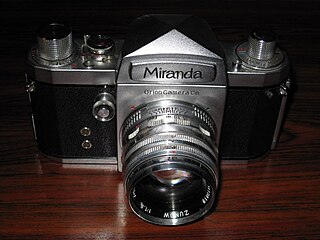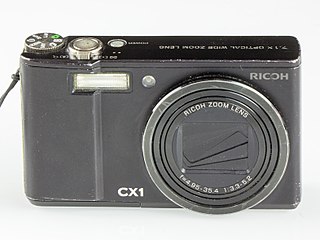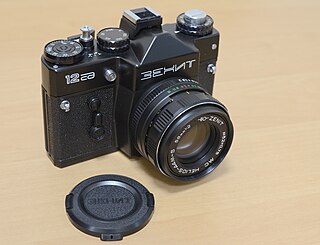 W
WThe 35mm SLR camera Alpa-Reflex has its origins back in the 1930s when a Swiss precision mechanical manufacturer decided to diversify their product range, having mainly relied on manufacturing parts for the watch industry. They sought outside assistance and by 1939 the plans were ready and building cameras commenced at a very slow rate. The camera was eventually named the Alpa because it was light, pocketable, and might easily be brought along travelling in the Alps. The Alpa-Reflex is only predated by the Kine Exakta, the Sport, and the Praktiflex 35mm SLRs. The manufacturer was Pignons S.A, Ballaigues, and the designer was Jacques Bolsky born December 31, 1895 in Kiev as Yakob Bogopolsky. He emigrated to the United States of America once the design was completed. He was also the inventor of the renowned Bolsey and Bolex cine cameras.
 W
WThe Asahi Pentax series, by the Asahi Optical Co., Ltd. , was a pivotal development in modern photography. They were the earliest Pentax cameras.
 W
WThe Contaflex series is a family of 35mm leaf-shuttered SLR cameras, produced by Zeiss Ikon in the 1950s and 1960s. The name was first used in 1935 on a 35mm Twin-lens reflex camera, the Contaflex TLR also by Zeiss Ikon, the -flex part in the name referring to integral mirror for the viewfinder. The first models, the Contaflex I and II have fixed lenses, while the later models have interchangeable lenses, and eventually the Contaflexes became a camera system with a wide variety of accessories.
 W
WThe Contarex is a 35mm SLR camera made by Zeiss Ikon. It was first presented at Photokina in 1958 and initially scheduled for delivery in the spring of 1959, but it was not made generally available until March 1960. It is popularly known as the Contarex I, the Bullseye or the Cyclops. The camera was aimed at the high-end and professional markets; in 1961, the retail price was $499.
 W
WThe Edixa Reflex cameras, introduced in 1954 were West Germany's most popular own series of SLR's with focal plane shutter. The original name of the first Edixa SLR was Komet. The Wirgin company had to change the name after complaints of two other companies with equally named products. Since 1955 the cameras got additional slow shutter speeds, and since 1956 cameras with aperture release shifter for the M42 lenses were available. Until 1959 four lines of Edixa SLRs were introduced:Type A, with shutter speeds up to 1/1000 sec. Type B, with aperture release mechanics Type C, with meter Type D, with exposure times up to 9 sec.
 W
WThe Exakta was a camera produced by the Ihagee Kamerawerk in Dresden, Germany, founded as the Industrie und Handels-Gesellschaft mbH, in 1912. The inspiration and design of both the VP Exakta and the Kine Exakta are the work of the Ihagee engineer Karl Nüchterlein, who did not survive the Second World War.
 W
WThe Kine Exakta was the first 35mm single-lens reflex (SLR) still camera in regular production. It was presented by Ihagee Kamerawerk Steenbergen GmbH, Dresden at the Leipziger Frühjahrsmesse in March 1936. The Exakta name was already used by Ihagee on a roll film SLR camera line since 1933, among these the Vest Pocket Exakta Model B from which the Kine Exakta inherited its general layout and appearance. The word Kine never appeared on the camera itself, only in the instruction manuals and advertising to distinguish it from the roll film variants. Several of its features constitute the foundation for the majority of 35mm SLR cameras produced ever since, although at this stage in an infant state.
 W
WThe Mecaflex is a 35mm SLR camera for 50 exposures of 24 × 24 mm. It was presented at the photokina in Cologne in 1951, and launched commercially about two years later. The design is by Heinz Kilfitt, who is also known for designing the original Robot camera and the Kowa Six.
 W
WThe original Miranda T 35mm SLR camera was launched by the newly established Japanese Orion Camera Co. in 1955. It is the first Japanese 35mm SLR camera to have an eyelevel Pentaprism finder. The camera was a success, and after only two years, the manufacturer changed its name to the Miranda Camera Co. The camera stayed in production for two more years while a series of new models designated model A, B, C, D, and S were introduced, based on the original camera. These comprised improvements like a faster shutter with 1/1000-second top speed, a frame counter, wind-on lever, and an Instant return mirror on model B in 1958. In addition, a rare Miranda TII with 1/1000-second top shutter speed does exist.
 W
WThe Pentacon Six is a single-lens reflex (SLR) medium format camera system made by East German manufacturer Pentacon from 1966 to 1992. The Six accepts lenses with the Pentacon Six mount, a breech-lock bayonet mount.
 W
WThe SX-70 is a folding single lens reflex Land camera which was produced by the Polaroid Corporation from 1972 to 1981.
 W
WPraktica was a brand of camera manufactured by Pentacon in Dresden in eastern Germany, formerly within the GDR prior to German reunification in 1990. The firm Pentacon was divided in mainly two parts and sold after German reunification. Schneider Kreuznach and Noble bought parts of it. Pentacon is a Dresden-based company in the optical and precision engineering industry, which was at times a major manufacturer of photo cameras. The name Pentacon is derived on the one hand from the Contax brand of the Dresden Zeiss Ikon Kamerawerke and Pentagon, because a pentaprism for SLR cameras developed for the first time in Dresden has this shape in cross section. Today's PENTACON GmbH Foto- und Feinwerktechnik is still based in Dresden. It is part of the Schneider Group, Bad Kreuznach. Pentacon is the modern-day successor to Dresden camera firms such as Zeiss Ikon; for many years Dresden was the world's largest producer of cameras. Previous brands of the predecessor firms included Praktica, Exa, Pentacon, Zeiss Ikon, Contax, Ica, Ernemann, Exakta, Praktiflex, and many more.
 W
WKamera-Werkstätten Guthe & Thorsch (K.W.) was established 1919 in Dresden by Paul Guthe and Benno Thorsch, starting out manufacturing the Patent Etui plate camera. Ten years later came the roll film TLR Pilot Reflex and in 1936, the 6×6 SLR Pilot range. By that time, Benno Thorsch, the surviving partner from 1919, decided to immigrate to the United States and arranged with the US citizen Charles Noble to swap enterprises. Noble came to Germany and moved the factory to Niedersedlitz on the outskirts of Dresden, while Benno Thorsch in Detroit ran the acquired photo finishing business that was one of the largest in the USA. The new Kamera-Werkstätten AG, Niedersedlitz prospered, and in 1939 launched the 35mm SLR Praktiflex camera. The concept proved successful, and through continuous development, the Praktica name became one of the most popular 35mm SLR brands for several decades, beginning in the 1950s.
 W
WThe Ricoh CX1 has been introduced by Ricoh in 2009. This is the first Ricoh camera to use a CMOS sensor. It allows it to operate at four frames/sec and perform hi-speed continuous shooting.
 W
WThe Ricoh XR-P is a 35mm Single Lens Reflex (SLR) camera introduced in 1984.
 W
WPetri TTL was a manual 35 mm SLR camera with TTL metering. It was built by Petri Camera Company, Japan, from 1974. It is unknown when the production stopped.
 W
WA single-lens reflex camera (SLR) is a camera that typically uses a mirror and prism system that permits the photographer to view through the lens and see exactly what will be captured. With twin lens reflex and rangefinder cameras, the viewed image could be significantly different from the final image. When the shutter button is pressed on most SLRs, the mirror flips out of the light path, allowing light to pass through to the light receptor and the image to be captured.
 W
WThe "Sport" camera is the series production model of a prototype camera called Gelveta. The Gelveta was designed and built by A. O. Gelgar between 1934 and 1935. It is the earliest known production 35mm SLR camera ever to be built, but fewer than 320 examples were made. The actual launch date of the "Sport" is somewhat uncertain, however it was in series production by 1936 and must undoubtedly be one of the two earliest generally available SLR cameras using the 35mm film format, the other being the German Ihagee Kine Exakta, launched in 1936. It was manufactured by the Soviet camera factory Gosudarstvennyi Optiko-Mekhanicheskii Zavod, The State Optical-Mechanical Factory in Leningrad. GOMZ for short. The camera name is engraved in Cyrillic on the finder housing above the lens: „Спорm“. The manufacturer's prism logo in gold on black with the factory initials ГОМЗ (GOMZ) is shown behind a circular magnifying window on the top left camera front. An estimated number of 19,000 cameras were made before Leningrad was besieged in September 1941 and suffered heavy damage. The design concept was not continued later.
 W
WThe Topcon RE Super, or Beseler Topcon Super D in USA, was launched by Tokyo Kogaku KK in 1963 and manufactured until 1971, at which point it was upgraded to the Super D and again to Super DM the following year. General sale continued for several years. These later models have a shutter release lock lever on the shutter release collar. It is a professional oriented 35mm SLR camera that had a comprehensive range of accessories available. It has a removable pentaprism viewfinder and focusing screen. It features the Exakta bayonet lens mount for interchangeable lenses. A special accessory shoe is situated at the base of the rewind knob with a standard PC sync. contact next to it. The release button is placed at the right-hand camera front, but there is no mirror-up facility; this was included on the upgraded versions. The standard lens is the RE. Auto-Topcor 1:1.4 f=5.8cm or the slightly slower 1:1.8 version. A battery-operated winder could be attached to the camera base.
 W
WZenit is a Russian camera brand manufactured by KMZ in the town of Krasnogorsk near Moscow since 1952 and by BelOMO in Belarus since the 1970s. The Zenit trademark is associated with 35 mm SLR cameras. Among related brands are Zorki for 35 mm rangefinder cameras, Moskva (Moscow) and Iskra for medium-format folding cameras and Horizon for panoramic cameras. In the 1960s and 1970s, they were exported by Mashpriborintorg to 74 countries.